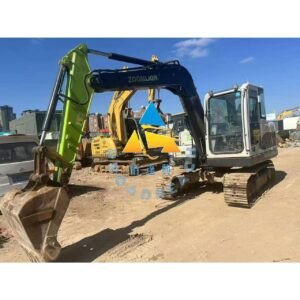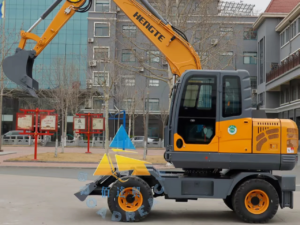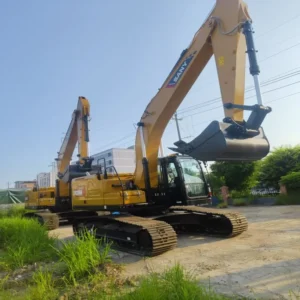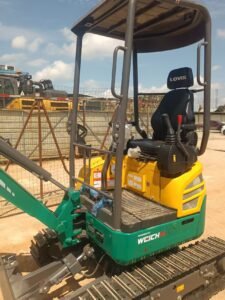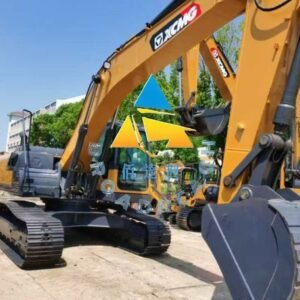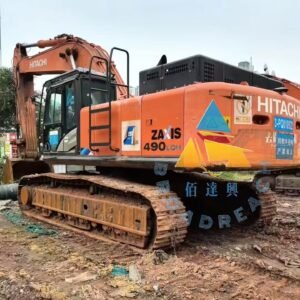BroadReach Construction Machinery Co., Ltd

Used Excavator Prices in 2025: Key Factors Influencing Cost
In 2025, the market for used excavators remains a critical segment of the global construction equipment industry, with prices influenced by a complex web of factors that reflect both immediate market conditions and long-term trends. For buyers and sellers alike, understanding these factors is essential to navigating the market effectively, whether seeking a cost-effective addition to a fleet or maximizing returns on a resale. This article explores the key elements shaping used excavator prices in 2025, offering insights into how equipment characteristics, market dynamics, and external regulations interact to determine costs.
1. Equipment Characteristics and Condition
The most direct and immediate factors affecting the price of a used excavator in 2025 are its inherent characteristics, including brand, model, age, usage history, and overall condition. These elements form the foundation of a machine’s value, as they directly impact its performance, reliability, and remaining lifespan.
Brand and Model Reputation
Brand recognition and model-specific performance play a significant role in determining resale value. Established manufacturers with a history of producing durable, high-performance equipment consistently command higher prices in the used market. For example, brands like Caterpillar, Komatsu, and Hitachi are renowned for their robust build quality and extensive parts availability, which translates to stronger resale values. A 2022 Caterpillar 336 GC, for instance, might retain 60-70% of its original price in 2025 if well-maintained, while a less well-known brand with similar specifications could retain only 40-50%.
Model popularity also matters. Certain models gain reputations for versatility, fuel efficiency, or suitability for specific tasks—such as urban construction or mining—which increases demand. Compact used excavators, ideal for tight spaces and light to medium work, remain in high demand in 2025 due to the growth of urban development projects. Models like the Bobcat E85 or Kubota KX080-4, therefore, often sell for 10-15% more than less popular compact models of similar age and condition.
Regional preferences further influence brand and model values. In Asia, brands like Sany and XCMG have gained significant market share due to their competitive pricing and improved reliability, making them sought-after in used markets across Southeast Asia and Africa. A used Sany SY215C, for example, might be priced 15-20% lower than a comparable Caterpillar model in these regions but still maintain strong demand due to lower maintenance costs and local parts availability.
Age and Usage Metrics
Age and usage, typically measured in hours of operation, are primary indicators of depreciation. In 2025, as in previous years, a used excavator’s age and hour count remain the most straightforward metrics for assessing its wear and tear. Generally, a machine with fewer than 1,000 hours of operation is considered “low-hour” and can retain 80-90% of its original price, assuming no major issues. In contrast, a machine with 5,000+ hours may sell for 30-50% of its new price, depending on maintenance.
However, age alone is not the sole determinant. A well-maintained 10-year-old excavator with 8,000 hours might outperform a poorly maintained 5-year-old machine with 6,000 hours, making its higher price justified. This is why detailed service records are invaluable—they provide evidence of regular maintenance, such as hydraulic system checks, engine overhauls, and replacement of critical components like tracks or buckets. A used excavator with comprehensive service documentation can command 10-20% more than a similar machine with incomplete or missing records.
Hours of Operation and Maintenance History
Hours of operation are a critical metric because they directly correlate with wear on key components, including the engine, hydraulic system, and undercarriage. In 2025, buyers increasingly use telematics data (where available) to verify hour counts and monitor usage patterns, such as whether the machine was primarily used for light digging or heavy lifting—tasks that impose different levels of stress on components. A machine used primarily for light work may have less wear on its hydraulic pumps, for example, than one used for daily heavy lifting, even with similar hour counts.
Maintenance history is equally important. Regular oil changes, filter replacements, and inspections prevent premature wear and extend component life. A used excavator that has undergone scheduled overhauls—such as a complete engine rebuild at 10,000 hours—can maintain a higher value than one that has not. Conversely, signs of neglect, such as rust, leaks, or unaddressed mechanical issues, can significantly reduce price. For example, a 2018 Komatsu PC210LC-11 with 7,000 hours and a documented history of hydraulic system servicing might sell for $120,000-$140,000 in 2025, while the same model with 7,000 hours but evidence of hydraulic leaks and poor maintenance could sell for $80,000-$100,000.
Upgrades and Technology Integration
Technological features have become increasingly important in determining used excavator values in 2025, as the industry continues to adopt advanced systems for efficiency, safety, and connectivity. Machines equipped with GPS-guided digging systems, 3D mapping software, or telematics platforms that allow remote monitoring of performance and maintenance needs are in higher demand. These features improve productivity and reduce downtime, making them attractive to fleet managers and construction companies focused on operational efficiency.
A used excavator with integrated telematics, such as Caterpillar’s Product Link or Komatsu’s Komtrax, can command 5-10% more than a similar model without these features, as buyers value the ability to track fuel usage, diagnose issues remotely, and schedule maintenance proactively. Similarly, machines with operator assist technologies—like automatic grade control or collision avoidance systems—are prized for their ability to reduce operator error and improve precision, further boosting their resale value.
The rise of hybrid and electric excavators in the new market has also impacted the used market. While fully electric models are still relatively new in 2025, early hybrid models from the 2020s, such as the Hitachi ZH210LC-5, are entering the used market and gaining attention for their lower fuel consumption and reduced emissions. These models often sell for 15-20% more than their traditional diesel counterparts of the same age, reflecting growing demand for eco-friendly equipment.

Market Supply and Demand Dynamics
Beyond the equipment itself, used excavator prices in 2025 are heavily influenced by the balance between supply and demand, which is shaped by broader economic trends, construction activity, and the availability of new equipment. These market forces can cause prices to fluctuate even for machines with identical characteristics, as shifts in demand or supply create competition among buyers or sellers.
Construction Activity and Infrastructure Investment
The level of construction activity globally is a primary driver of demand for used excavators. In 2025, several regions are experiencing significant infrastructure growth, fueling demand for equipment. The United States, for example, continues to benefit from the Infrastructure Investment and Jobs Act (IIJA), which allocates billions to road, bridge, and broadband projects, increasing the need for excavators of all sizes. Similarly, the European Union’s focus on renewable energy infrastructure—including wind farms and solar installations—has boosted demand for excavators suitable for heavy lifting and site preparation.
In emerging markets, rapid urbanization and investment in transportation networks are driving demand for used excavators, as these regions often prioritize cost-effective equipment over new purchases. Countries like India, Brazil, and Vietnam are seeing sustained growth in construction activity, with used excavators accounting for 60-70% of equipment acquisitions in these markets. This high demand can push prices up by 5-10% for well-maintained machines, particularly in regions where supply is limited.
Conversely, economic slowdowns or reduced construction spending can lead to a surplus of used excavators, driving prices down. If a major economy experiences a recession in 2025, for instance, construction companies may delay fleet expansions or sell off underutilized equipment, increasing supply in the used market and putting downward pressure on prices.
Availability of New Excavators
The supply of new excavators directly impacts the used market. In 2025, if new equipment production is constrained by supply chain issues—such as shortages of critical components like hydraulic pumps or semiconductors—buyers may turn to the used market, increasing demand and pushing prices up. Conversely, a surge in new excavator production can lead to an influx of used machines as companies replace older models, increasing supply and stabilizing or lowering used prices.
The introduction of new technologies in the new market also affects used values. For example, the growing availability of fully electric excavators in 2025 may reduce demand for older diesel models, particularly in regions with strict emissions regulations. This could lead to price declines for used diesel excavators that do not meet the latest emissions standards, even if they are in good condition.
Export and Import Trends
Global trade flows play a significant role in shaping regional used excavator prices. Countries with large fleets of aging equipment often export used excavators to regions with high demand, balancing supply and demand across borders. Japan, for example, remains a major exporter of used construction equipment, including excavators, to markets in Africa, the Middle East, and Southeast Asia. In 2025, if Japanese exports increase due to domestic fleet renewal, this could lower prices in importing regions by increasing supply.
Conversely, import restrictions or tariffs can disrupt these flows and affect prices. A country imposing higher tariffs on used equipment imports to protect domestic manufacturing may see reduced supply, leading to higher prices for used excavators within its borders. Currency exchange rates also impact export and import dynamics: a strong U.S. dollar in 2025, for instance, could make American-used excavators more expensive for buyers in regions with weaker currencies, reducing demand and pressuring sellers to lower prices.
Regulatory and Environmental Factors
Increasingly strict regulations related to emissions, safety, and equipment standards are reshaping the used excavator market in 2025, with compliance directly affecting a machine’s value and marketability. These regulations vary by region but collectively influence which used excavators are in demand and how much they can sell for.
Emissions Standards
Emissions regulations are among the most impactful regulatory factors. In 2025, regions like the European Union (EU) and North America enforce strict standards—such as the EU’s Stage V and the U.S. Environmental Protection Agency’s (EPA) Tier 4 Final—which limit the amount of pollutants emitted by diesel engines. Used excavators that meet these standards are more valuable in these regions, as they can be operated legally without modifications. Machines that do not meet these standards may be restricted or banned from use in certain areas, significantly reducing their value.
For example, a used excavator compliant with Tier 4 Final emissions standards might sell for 20-30% more in the United States in 2025 than a similar machine that only meets Tier 3 standards, which are no longer legal for new equipment but may still be allowed in some regions. In contrast, in regions with less strict emissions regulations, the price difference between compliant and non-compliant machines is smaller, as the latter can still be operated freely.
China, the world’s largest market for construction equipment, has also implemented stringent emissions standards, including the China IV standard, which aligns with EU Stage IV requirements. Used excavators that meet China IV standards command higher prices in China and in export markets that recognize these standards, while older models may be restricted to regions with laxer regulations, lowering their resale value.
Safety and Operational Regulations
Regulations related to safety features are another key factor. In 2025, many regions require used excavators to be equipped with safety technologies such as roll-over protective structures (ROPS), falling object protective structures (FOPS), and operator presence systems. Machines lacking these features may require retrofitting to be legally operated, which adds costs for buyers and reduces the machine’s resale value.
For example, in the EU, any used excavator sold must comply with the Machinery Directive, which mandates specific safety features. A machine without updated safety systems might sell for 10-15% less than a similar model that is fully compliant, as buyers factor in the cost of retrofits.
Environmental Policies and Incentives
Government policies promoting sustainability and reducing carbon footprints are increasingly influencing equipment choices, including in the used market. In 2025, regions offering incentives for using low-emission equipment—such as tax breaks or subsidies for hybrid or electric machines—may see increased demand for used eco-friendly excavators, driving up their prices.
Conversely, policies aimed at phasing out high-emission equipment can devalue older diesel models. For instance, if a city or country announces plans to ban diesel-powered construction equipment in urban areas by 2030, demand for used diesel excavators in that region may decline in 2025, leading to lower prices as sellers rush to offload them before the ban takes effect.
Conclusão
In 2025, used excavator prices are shaped by a multifaceted interplay of equipment characteristics, market dynamics, and regulatory factors. For buyers, understanding these factors can help identify the best value options—whether prioritizing a well-maintained, high-reputation model or leveraging regional supply-demand imbalances for cost savings. For sellers, highlighting strong maintenance records, compliance with regulations, and desirable features can maximize resale value.
As the construction industry continues to evolve, with a growing focus on sustainability and technology, these factors will remain critical, adapting to new trends such as the rise of electric equipment and shifting global infrastructure priorities. By staying informed about these dynamics, participants in the used excavator market can make more strategic decisions, ensuring they navigate the 2025 landscape with confidence. Whether buying or selling, the key is to recognize that a used excavator’s price is more than just a number—it reflects a complex blend of performance, demand, and compliance that defines its place in the global construction ecosystem.

